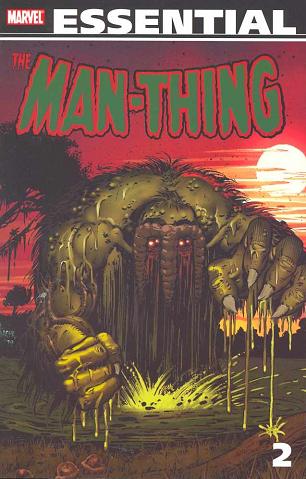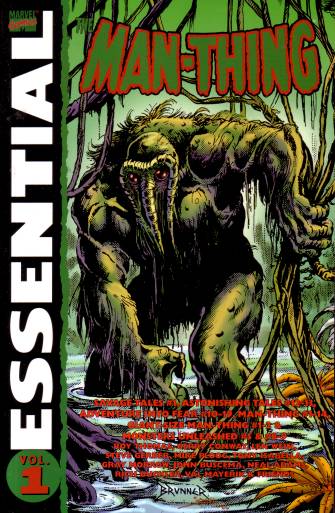
Essential Man-Thing Vol. 02
Steve Gerber, Michael Fleisher, Chris Claremont and friends
Reprints: Man-Thing #15-22, Giant-Size #3-5, Man-Thing v2 #1-11 (March 1975 – July 1981)
Get this for: The second part of Gerber’s run — four stars
The Marvel Essentials series is meant to sell you characters, rather than creators — buy a volume and you get a big slab of Spider-Man’s adventures, or the Fantastic Four’s — but with some series this approach just doesn’t work. Man-Thing is one such series. Only one writer ever got a handle on the muck monster and nobody before or after him really knew what to do with him. That writer was Steve Gerber of course, whose work dominated the first volume of Essential Man-Thing. The second volume collects the remainder of his run on the first Man-Thing, but also the complete second, 1979 series, written by Michael Fleisher and Chris Claremont. It’s clear neither of them got the Man-Thing as Gerber got him.
Man-Thing is after all a difficult character to write. He’s completely passive, with no motives of his own, solely responding to the emotions of the people around him. You can’t have the usual Marvel soap opera with Man-Thing, it’s difficult to get him to fight recurring villains and really the best thing you can do with him is to use him in morality tales. Which both Gerber and his successors did, with the difference that Gerber had his finger on the pulse of the seventies and the talent to make use of it. He was also able to see the absurdity in his stories, which helps a lot when reading much dated relevant stories. But he also moved people with his stories, especially “the Kid’s Night Out” from Giant-Size Man-Thing #4, as witnessed in this remembrance by Fred Hembeck. In it Man-Thing is the avenger of a fat kid who died of exhaustion during gym class, while the people that tormented him mouth platitudes at his funeral, lashing out in anger when his one friend challenges their lies. It’s dated yes and I’ve read hundreds of such stories, but I can see the power it must have had on people like Hembeck back then
For an example of how not to do a Man-Thing story, we need look no further than Giant-Size Man-Thing #5 and a Len Wein story. Wein, who created Manny’s counterpart at DC, Swamp Thing, should’ve been able to handle him, but his story of two young lovers running away into the swamp to get away from their feuding parents is a) cliche and b) very very dull, a sort of third rate EC Comics shock story. That’s the mistake in many of the non-Gerber stories, taken it all too seriously and going for shock rather than creativity, upping the death count along the way. It doesn’t make them any better.
On the art side, most of it is by dependable Marvel veterans like Jim Mooney, Ed Hannigan and Don Perlin. None of them are bad and some like Hannigan do their best work here, but it’s not as good as the art in the previous volume, which of course boasted Mike Ploog, who is hard to improve on. It’s the standard seventies Marvel house style on display here, when Manny really needs something special.
Not a bad volume and Chris Claremont at least tries to do what Gerber does seemingly effortlessly, but in the end it shows that some characters can only be handled by one specific writer.
